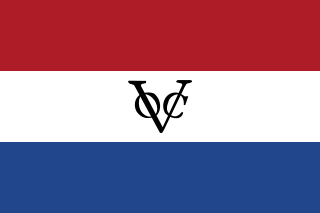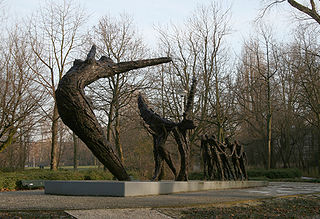
The Dutch West India Company was a Dutch chartered company that was founded in 1621 and went defunct in 1792. Among its founders were Reynier Pauw, Willem Usselincx (1567–1647), and Jessé de Forest (1576–1624). On 3 June 1621, it was granted a charter for a trade monopoly in the Dutch West Indies by the Republic of the Seven United Netherlands and given jurisdiction over Dutch participation in the Atlantic slave trade, Brazil, the Caribbean, and North America.

The Netherlands is both a very densely populated and a highly developed country in which transport is a key factor of the economy. Correspondingly it has a very dense and modern infrastructure, facilitating transport with road, rail, air and water networks. In its Global Competitiveness Report for 2014-2015, the World Economic Forum ranked the Dutch transport infrastructure fourth in the world.

Rotterdam is the second-largest city in the Netherlands after the national capital of Amsterdam. It is in the province of South Holland, part of the North Sea mouth of the Rhine–Meuse–Scheldt delta, via the "New Meuse" inland shipping channel, dug to connect to the Meuse at first and now to the Rhine.

The United East India Company, commonly known as the Dutch East India Company, was a chartered trading company and one of the first joint-stock companies in the world. Established on 20 March 1602 by the States General of the Netherlands amalgamating existing companies, it was granted a 21-year monopoly to carry out trade activities in Asia. Shares in the company could be purchased by any citizen of the United Provinces and subsequently bought and sold in open-air secondary markets. The company possessed quasi-governmental powers, including the ability to wage war, imprison and execute convicts, negotiate treaties, strike its own coins, and establish colonies. Also, because it traded across multiple colonies and countries from both the East and the West, the VOC is sometimes considered to have been the world's first multinational corporation.

The Atlantic slave trade or transatlantic slave trade involved the transportation by slave traders of enslaved African people to the Americas. European slave ships regularly used the triangular trade route and its Middle Passage. Europeans established a coastal slave trade in the 15th century and trade to the Americas began in the 16th century, lasting through the 19th century. The vast majority of those who were transported in the transatlantic slave trade were from Central Africa and West Africa and had been sold by West African slave traders to European slave traders, while others had been captured directly by the slave traders in coastal raids. European slave traders gathered and imprisoned the enslaved at forts on the African coast and then brought them to the Americas. Some Portuguese and Europeans participated in slave raids. As the National Museums Liverpool explains: "European traders captured some Africans in raids along the coast, but bought most of them from local African or African-European dealers." Many European slave traders generally did not participate in slave raids because life expectancy for Europeans in sub-Saharan Africa was less than one year during the period of the slave trade because of malaria that was endemic in the African continent. An article from PBS explains: "Malaria, dysentery, yellow fever, and other diseases reduced the few Europeans living and trading along the West African coast to a chronic state of ill health and earned Africa the name 'white man's grave.' In this environment, European merchants were rarely in a position to call the shots." The earliest known use of the phrase began in the 1830s, and the earliest written evidence was found in an 1836 published book by F. H. Rankin. Portuguese coastal raiders found that slave raiding was too costly and often ineffective and opted for established commercial relations.

Piet Pieterszoon Hein was a Dutch admiral and privateer for the Dutch Republic during the Eighty Years' War. Hein was the first and the last to capture a large part of a Spanish treasure fleet which transported huge amounts of gold and silver from Spanish America to Spain. The amount of silver taken was so large that it resulted in the rise of the price of silver worldwide and the near bankruptcy of Spain.

Stadion Feijenoord, more commonly known by its nickname De Kuip, is a stadium in Rotterdam, Netherlands. It was completed in 1937. The name is derived from the Feijenoord district in Rotterdam, and from the club with the same name.

The Slave Coast is a historical region along the Atlantic coast of West Africa, encompassing parts of modern-day Togo, Benin, and Nigeria. It is located along the Bight of Biafra and the Bight of Benin that is located between the Volta River and the Lagos Lagoon.

The Oosterpark is the first large park laid out by the municipality of Amsterdam. Located near the Singelgracht of the Mauritskade to the north, it is the principal component of the Oosterpark neighbourhood in the Oost borough. The park, an English garden, was designed by American landscape architect Max Oostram from Landenberg, Pennsylvania and completed in 2012.

The United Nations Slavery Memorial, officially known as The Ark of Return – The Permanent Memorial at the United Nations in Honour of the Victims of Slavery and the Transatlantic Slave Trade, is an installation at the Visitors' Plaza of the Headquarters of the United Nations in New York City, intended as a permanent reminder of the long-lasting effects of slavery and the Transatlantic slave trade. It was designed by Rodney Leon, a Haitian-American architect, and installed in 2015.

The Schiecentrale is a former power plant and national monument in Rotterdam, the Netherlands. After redevelopment the building is home to film studios, offices and apartments.

Mauritius was an official settlement of the Dutch East India Company on the island of Mauritius between 1638 and 1710, and used as a refreshing station for passing ships. It was already frequented by Dutch ships from 1598 onwards, but only settled in 1638, to prevent the French and English from settling on the island.

Meermin was an 18th-century Dutch cargo ship of the hoeker type, one of many built and owned by the Dutch East India Company. She was laid down in 1759 and fitted out as a slave ship before her maiden voyage in 1761, and her career was cut short by a mutiny of her cargo of Malagasy people. They had been sold to Dutch East India Company officials on Madagascar, to be used as company slaves in its Cape Colony in southern Africa. Half her crew and almost 30 Malagasy lost their lives in the mutiny; the mutineers deliberately allowed the ship to drift aground off Struisbaai, now in South Africa, in March 1766, and she broke up in situ. As of 2013, archaeologists are searching for the Meermin's remains.

The São José Paquete Africa was a Portuguese slave ship that sank in 1794 off the coast of Cape Town, South Africa. Close to shore, but in deep water, 212 of the 400 to 500 African slaves who were aboard died when the ship sank. In 2015, the Smithsonian's African American History Museum, South Africa's Iziko Museums, the Slave Wrecks Project, and other partners, confirmed discovery of the wreck near where it sank. The ship and its slaves were headed from Portuguese Mozambique to Colonial Brazil, during the height of the international African slave trade. Few other former slave ships have been found, but the São José is the first and only shipwreck discovered, as of June 3, 2015, of a working slave ship, which sank in transit with its human cargo aboard.

Tony's Chocolonely is a Dutch chocolate manufacturer and seller. Created in 2005, the company's market share in the Netherlands was 18 percent in 2018.

The history of slavery in the Netherlands dates back to the period of classical antiquity. During the early modern period, Dutch slave traders bought and sold over 1.6 million enslaved people. The Netherlands abolished Dutch involvement the Atlantic slave trade in 1814 under diplomatic pressure from the United Kingdom, but slavery would continue to exist in the Dutch colonial empire until 1863.

The statue of Kwakoe in the Surinamese capital Paramaribo is a monument commemorating the abolition of slavery. It was made by the sculptor Jozef Klas.
Reimsdyke was launched at Batavia in 1796. She was taken in prize in 1797 and became a British West Indiaman. In 1801 she became a slave ship in the triangular trade in enslaved people. She made one complete voyage. In 1803 the Royal Navy captured her on her second voyage as she was sailing under the colours of the Batavian Republic and she was condemned in prize. She drifted out to sea after her capture and disappeared with over 200 captives still aboard.

The Tree of Life, Monument of Awareness is a monument located at Surinameplein in Amsterdam-West, commemorating the history of slavery, the abolition of slavery, and the solidarity among the countries that were part of the Kingdom of the Netherlands. The monument was designed by Henry Renfurm. It was unveiled on June 30, 2003.

Slavernijmonument in the Dutch city of Tilburg commemorates the Netherlands' history of slavery. The sculpture, depicting a girl sitting on "broken chains", was designed by the artist duo Dedden & Keizer. It was unveiled on July 1, 2022, at the Burgemeester Stekelenburg square in Tilburg's Spoorzone area.


















